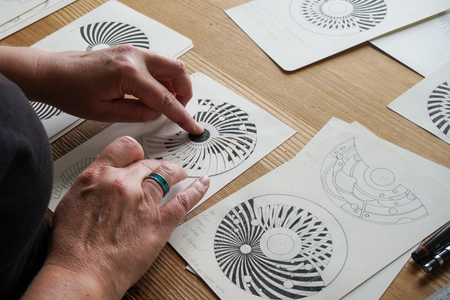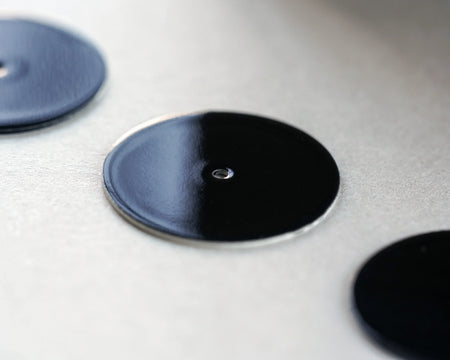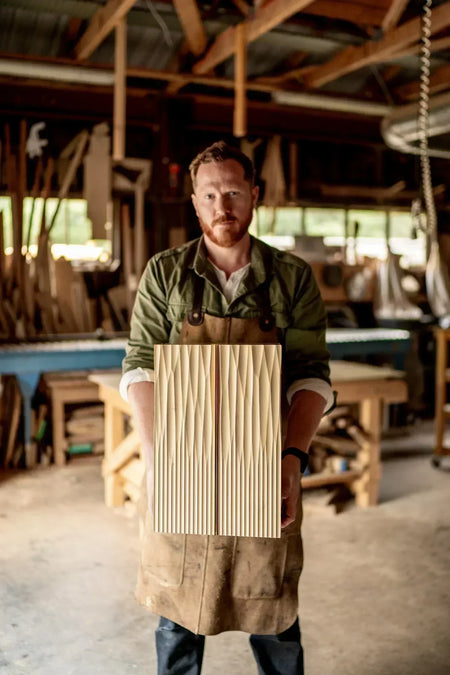The success of the anniversary watch prompted the enamelling team to start exploring different ways to utilise champlevé for the Model 3 dial. Champlevé is rarely used for watches (although the limited edition A Lange Sohne is a fine example of it in horological action). It is, however, a technique widely used in jewellery design, but it is not without its pitfalls - a lesson our enamellers would soon learn.
During this time, cases for our next watch, the Model 3, had been designed and delivered to the studio. However, these cases had been made to accommodate a regular watch dial and the change in direction away from the original Model 3 design meant that they now lacked the extra depth required for a champlevé enamel dial.
The enamellers teamed up with a Birmingham-based tool-maker to create the metal dial base. Champlevé enamelling involves the creation of cells within a metal base and subsequently filling the carved-out hollows with enamel. There are several ways to make these hollows, including acid washing, engraving and etching. In this case, however, dies were created to stamp the silver disc into shape with a hydraulic press.
But trying to obtain depth from a flat surface isn’t easy. Nor is working with a brand new technique, while also adhering to the constraints of predesigned watch cases. Our enamellers were determined to create as much depth within the dial base as possible, while simultaneously accommodating enough height for the watch’s indices to stand out. Through their sheer determination, it took multiple back-and-forths between the studio and the tool-maker to ensure the die and dial base turned out perfectly.
The next step was to focus on the enamelling. With all enamelling processes, there is a degree of trial and error, as metal and enamel have different rates of expansion and contraction. As enamelling requires multiple firings in an extremely hot kiln, this can cause problems.
Warpage is one such issue that can arise. As the two materials heat up and cool down, tension between the metal base and the enamel can occur, due to their different expansion rates. This is easier to manage when working with a flat piece of metal, such as the copper and silver dials of the M1 and M2. However, the fluctuating density of the metal in champlevé enamelling also means that there are various expansion rates within the base itself, which makes it susceptible to complicated warpage. Such warpage is tricky to deal with and makes the enamel sitting on top much more vulnerable to cracking or even chipping off entirely.
To remedy this, our enamelling team have been treating the task as a scientist would an experiment. Altering one variable at a time, the team have been testing factors such as the thickness and structure of the dial blanks, counter-enamelling the metal base, measuring the thickness of the counter-enamel, the type of enamel used, the kiln temperature and firing times. For more than ten months now, the team have been exploring every option to bring you what will become our latest offering.
The team have also altered the design process. Whereas before the team were attempting to reverse engineer the dial to fit the case, now the dial design takes precedence. Once the team master the champlevé process, they will redesign the case in accordance.
Additionally, the typography of the hour markers is undergoing a redesign. The numerals constitute the raised elements of the champlevé dial, and the initial design meant that their tiny sharp corners and enclosed loops, such as those found in zeroes and eights, created additional stress between the metal and the enamel. Now the numerals are thicker, reducing these points of tension and decreasing the likelihood of the enamel cracking.
The overall aesthetic for the Model 3 is relatively simple but hugely effective. Featuring only the 12 numbers of the hour markers, if we had chosen to print them on, it would have felt as though something was missing. However, the intricate delicacy of champlevé enamelling ensures that simplicity in design thrives and that anything additional on the dial would be too much. It is the perfect combination of design and craftsmanship working together.
The success rate for an uncracked dial is now at 10-30%, which shows progress but, sadly, it is not high enough for commercial production. It has been a long process, but the vigilance and patience of our enamellers is testament to their dedication to the craft. They continue to experiment and practise, all while fulfilling current orders for our other models.
There is light at the end of the tunnel for the Model 3. The beauty of the champlevé dial, when successful, is extraordinary and is just one reason why we are persevering with the concept. There’s a bit more work to be done, but we assure you it’ll be worth it in the end.
Stay tuned - we can’t wait to show it to you!




